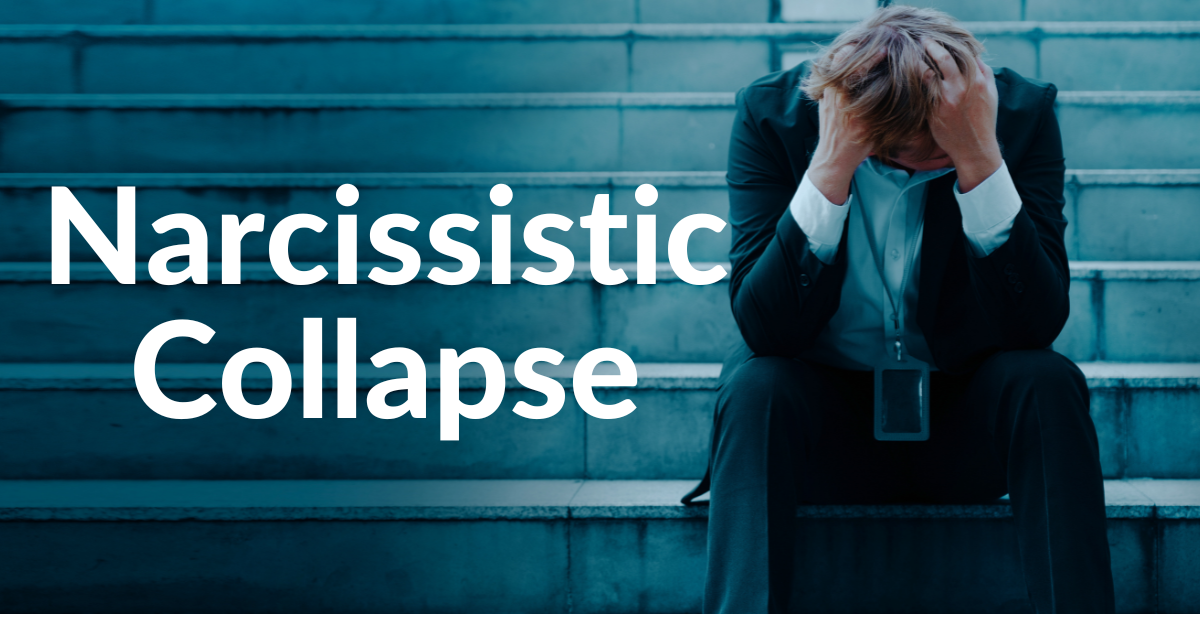Narcissistic collapse refers to a profound breakdown in the personality structure of individuals with narcissistic personality disorder (NPD). It is a complex phenomenon characterized by the disintegration of the grandiose self-image and the subsequent manifestation of emotional instability and self-doubt.
This article explores the concept of narcissistic collapse, shedding light on its recognition, underlying psychological factors, the process involved, its impact on relationships, coping strategies, and ultimately, the healing and recovery process.
Understanding Narcissism
To comprehend narcissistic collapse, it is crucial to first understand narcissism itself. Narcissism is a personality trait characterized by excessive self-centeredness, an inflated sense of superiority, and a deep craving for admiration and validation from others. Individuals with NPD exhibit an exaggerated sense of self-importance and a lack of empathy for others.
What is Narcissistic Collapse?
Narcissistic collapse occurs when the carefully constructed facade of invulnerability and grandiosity maintained by individuals with NPD begins to crumble. This collapse exposes the underlying fragility, insecurity, and profound inner emptiness that the narcissist strives to conceal. It is a profound unraveling of the false self, often triggered by external events that challenge the narcissist’s self-image and core beliefs.
Signs of Narcissistic Collapse

There are following signs of narcissistic collapse:
1. Emotional Instability
Narcissistic collapse is often accompanied by intense emotional turmoil. The narcissist may experience extreme mood swings, ranging from explosive anger and rage to profound sadness and despair. Their emotional state becomes increasingly erratic and unpredictable.
2. Extreme Self-Doubt
As the narcissistic facade crumbles, the individual experiences an overwhelming sense of self-doubt. They may question their abilities, accomplishments, and even their own worth. This profound self-doubt erodes the grandiose self-image that once defined them.
3. Loss of Grandiosity
One of the defining characteristics of narcissism is the inflated sense of self-importance and grandiosity. During a collapse, this grandiosity dissipates, leaving the narcissist feeling small, insignificant, and stripped of their illusions of superiority.
4. Fear of Abandonment
Narcissistic collapse often triggers a deep fear of abandonment in individuals with NPD. They become hyper-vigilant about losing the attention and admiration of others, as their primary source of validation crumbles along with their false self.
5. Self-Isolation and Withdrawal
To shield themselves from further perceived threats to their fragile self-image, narcissists in collapse may retreat into self-imposed isolation. They may withdraw from social interactions, cut ties with loved ones, and avoid situations that could expose their vulnerabilities.
Narcissistic Collapse Examples
Here are five hypothetical examples of what a narcissistic collapse might look like. Please note that these are generalized scenarios and the specifics can vary greatly depending on the individual:
- Public Humiliation: A well-respected CEO is exposed by the media for unethical business practices. This public humiliation shatters his image of being an infallible and successful leader, leading to a narcissistic collapse.
- Failed Relationship: A person who always saw themselves as the perfect partner goes through a messy breakup. Their partner, who they thought would never leave them, ends the relationship citing emotional abuse and the person’s inability to empathize or compromise. This could lead to a narcissistic collapse as their self-perception is seriously challenged.
- Professional Failure: A surgeon, who prides herself on her flawless record, makes a critical mistake during an operation leading to severe complications for the patient. The incident, along with the subsequent investigation and possible legal action, could trigger a narcissistic collapse.
- Loss of Social Status: A popular socialite loses their wealth due to bad investments. As they can no longer afford the luxurious lifestyle they’re used to, their friends start distancing themselves. This sudden fall from grace and loss of social status can lead to a narcissistic collapse.
- Aging and Loss of Physical Abilities: An athlete who has always prided himself on his physical prowess and appearance starts aging and can no longer perform as he used to. The realization of this loss can cause a narcissistic collapse, especially if their identity was strongly tied to their athletic abilities.
Remember, these are just examples. Each person’s experience with narcissism and narcissistic collapse is unique and can be influenced by many factors.
Triggers for Narcissistic Collapse

There are some causes to trigger Narcissistic collapse:
1. Loss of Narcissistic Supply
Narcissistic supply refers to the attention, admiration, and validation that narcissists crave to sustain their inflated self-image. When the sources of narcissistic supply diminish or disappear, such as when their accomplishments are challenged or their admirers move on, it can trigger a collapse.
2. Criticism or Failure
Narcissists have a deep-rooted fear of criticism and failure. When faced with criticism or experiencing failure, the carefully constructed defenses of the narcissist start to crumble, leading to a collapse. These triggers puncture the grandiose self-image and expose the underlying fragility.
3. Betrayal or Rejection
Betrayal or rejection, particularly by those the narcissist holds in high regard, can act as catalysts for a collapse. When their trust is shattered or they experience rejection from a source they deemed important, it reinforces their core belief of being unworthy, leading to a collapse.
Psychological Factors Behind Narcissistic Collapse
Following psychological factors behind narcissistic collapse:
1. Inflated Ego as a Defense Mechanism
Narcissistic individuals build an inflated ego as a defense mechanism to shield themselves from deep-rooted feelings of inadequacy and unworthiness. This defense mechanism serves to protect their fragile self-esteem by projecting a false sense of superiority onto others.
2. Deep-Rooted Insecurity
Beneath the facade of grandiosity lies profound insecurity. Narcissists harbor deep-seated feelings of inadequacy and self-doubt, often stemming from childhood experiences. The collapse occurs when these insecurities can no longer be concealed, and the facade begins to crumble.
3. Lack of Empathy and Emotional Nurturing
Narcissistic collapse can be traced back to core wounds inflicted during childhood. A lack of empathy and emotional nurturing from caregivers results in the stunted development of healthy self-esteem and coping mechanisms, leaving the individual vulnerable to narcissistic traits.
4. Role of Neglect or Abuse
Childhood neglect or abuse can further exacerbate the development of narcissism. Emotional, physical, or psychological abuse can instill a profound sense of unworthiness and detachment, which the individual attempts to compensate for by constructing a grandiose self-image.
5. Discrepancy between Self-Image and Reality
Narcissistic individuals often maintain an idealized self-image that is disconnected from reality. This discrepancy between their grandiose self-perception and the harsh reality they face creates inner conflicts. When these conflicts intensify and become unmanageable, a collapse ensues.
6. Fear of Exposure or Vulnerability
Narcissists go to great lengths to avoid vulnerability and exposure. The collapse occurs when external circumstances or internal turmoil threaten to unveil their true self, forcing them to confront their fear head-on.
Stages of Narcissistic Collapse

There are three stages of narcissistic collapse:
Stage 1: Initial Triggers and Denial
- External Challenges to the Narcissistic Self: The collapse begins with external challenges that puncture the narcissistic self-image. These challenges can come in the form of criticism, failure, loss of admiration, or betrayal. Initially, the narcissist may deny or dismiss these challenges to protect their fragile ego.
- Denial of Vulnerability and Fragility: Narcissists are adept at denying their vulnerability and fragility. In this stage, they may fiercely reject any notion of weakness or imperfection, refusing to acknowledge the impending collapse and clinging to the illusion of invincibility.
Stage 2: Emotional Turmoil and Self-Doubt
- Intense Emotional Dysregulation: As denial weakens, intense emotional dysregulation takes hold. The narcissist experiences a rollercoaster of emotions, ranging from anger and despair to confusion and despair. This emotional turbulence shatters their carefully constructed emotional armor.
- Shattered Illusions of Superiority: With emotional turmoil comes the realization that their illusions of superiority were merely facades. The narcissist confronts the painful truth that their grandiosity was built on shaky ground, leading to a profound erosion of self-esteem and self-image.
C. Stage 3: Desperate Attempts to Restore Self-Image
- Manipulative Tactics and Control: In an attempt to regain a sense of control and restore their shattered self-image, narcissists may resort to manipulative tactics. They may engage in gaslighting, blame-shifting, or other forms of emotional manipulation to protect their fragile ego.
- Seeking New Sources of Narcissistic Supply: During the collapse, narcissists become desperate to replenish their diminished narcissistic supply. They may seek out new sources of admiration and validation, often discarding or devaluing previous sources that no longer serve their needs.
How long does narcissistic collapse last?
The duration of a narcissistic collapse can vary significantly from person to person and depends on a variety of factors. Since narcissistic collapse is not a clinically defined term or a formal diagnosis, the timeline and characteristics can be quite different for each individual experiencing it. However, several factors can influence the duration and severity of the collapse:
- Severity of the Narcissistic Traits: Individuals with more severe narcissistic traits or those with Narcissistic Personality Disorder (NPD) may experience a longer and more intense collapse.
- Nature of the Triggering Event: The event that triggers the collapse, such as a significant public humiliation, loss of a key relationship, or a major professional failure, can influence its duration. More impactful events may lead to a longer-lasting collapse.
- Support Systems: The presence or absence of a supportive social network can significantly impact the duration of the collapse. Individuals with a strong support system may recover more quickly.
- Coping Mechanisms and Resilience: The individual’s usual coping mechanisms, psychological resilience, and ability to adapt to stress will affect how long the collapse lasts and how they navigate through it.
- Professional Help and Therapy: Access to professional psychological help can be crucial in dealing with a narcissistic collapse. Therapy can provide tools and insights to help the individual understand and manage their narcissistic traits, potentially shortening the duration of the collapse.
- Willingness to Change and Self-Reflect: If the individual is willing to engage in self-reflection and acknowledges the need for change, this can lead to a more constructive and shorter collapse period.
- Underlying Mental Health Issues: The presence of other mental health issues, such as depression or anxiety, can complicate and potentially prolong the recovery from a narcissistic collapse.
In general, a narcissistic collapse can last from weeks to months, and in some cases, even longer. It’s a highly individual process, influenced by the person’s psychological makeup, the circumstances of the collapse, and the response to it, both from the individual and their environment. Professional guidance is often essential in navigating this challenging period.
Impact on Relationships and Interpersonal Dynamics
1. Strained Marriages and Divorce
Narcissistic collapse takes a toll on intimate relationships. The emotional instability, self-doubt, and manipulative behaviors push partners away, leading to strained marriages and, in some cases, divorce.
2. Narcissistic Abuse and Emotional Manipulation
During the collapse, narcissists may escalate their abusive tendencies as a means to regain control. They engage in emotional manipulation, gaslighting, and exploitation to keep others entangled in their web of dysfunction.
3. Workplace Conflicts and Power Struggles
Narcissistic collapse often spills over into the professional realm. The narcissist’s emotional instability and desperate need for validation can lead to conflicts and power struggles in the workplace.
4. Lack of Teamwork and Collaboration
Due to their self-centered nature, narcissists struggle with teamwork and collaboration. The collapse intensifies this difficulty, as their emotional instability and fear of vulnerability hinder their ability to cooperate effectively with others.
5. Loss of Friends and Social Support
The collapse may result in the loss of friends and social support networks. The narcissist’s manipulative behaviors, combined with their self-isolation and emotional turmoil, alienate those around them, leaving them socially isolated.
5. Difficulty in Forming Genuine Connections
Narcissistic collapse makes it challenging for individuals to form genuine connections. Their fear of vulnerability and their constant need for validation hinder their ability to establish meaningful relationships based on trust and mutual respect.
Coping Strategies for Narcissistic Collapse
- Facing Reality and Personal Growth: Coping with narcissistic collapse begins with self-reflection and acceptance. The individual must confront their flaws and acknowledge the reality of their situation. This process opens the door to personal growth and transformation.
- Building Self-Compassion and Empathy: Developing self-compassion and empathy is essential for healing. By cultivating compassion for oneself, individuals can begin to understand and empathize with the experiences and emotions of others, paving the way for healthier relationships.
- Psychotherapy and Counseling: Psychotherapy, particularly modalities such as psychodynamic therapy or schema therapy, can help individuals navigate the complexities of narcissistic collapse. Therapists provide a supportive environment to explore underlying issues and develop healthier coping mechanisms.
- Cognitive-Behavioral Techniques: Cognitive-behavioral techniques, such as cognitive restructuring and mindfulness, can assist in challenging and modifying distorted thinking patterns and reducing emotional dysregulation. These techniques promote self-awareness and facilitate adaptive responses to triggers.
- Understanding and Validation: Seeking support from understanding individuals or joining support groups can be immensely beneficial. Connecting with others who have experienced or witnessed narcissistic collapse provides validation and a sense of belonging.
- Connecting with Empathetic Individuals: Building connections with empathetic individuals fosters personal growth and healing. Interacting with people who can provide genuine empathy and support can help individuals rebuild their capacity for trust and healthy relationships.
Healing and Recovery from Narcissistic Collapse
- Redefining Success and Personal Worth: Healing from narcissistic collapse involves redefining success and personal worth beyond external validation. Individuals must focus on intrinsic values and cultivate a sense of self-worth based on genuine qualities and accomplishments.
- Engaging in Self-Care and Self-Development: Practicing self-care and engaging in activities that foster self-development are crucial in the recovery process. Nurturing one’s physical, emotional, and psychological well-being rebuilds resilience and fosters personal growth.
- Cultivating Empathy and Emotional Intelligence: Recovering from narcissistic collapse requires developing empathy and emotional intelligence. By actively practicing empathy and understanding others’ emotions, individuals can forge deeper and more authentic connections.
- Establishing Trust and Respect: Rebuilding trust and respect in relationships is vital. Individuals must demonstrate consistent trustworthy behavior and respect the boundaries of others. This fosters healthier dynamics and strengthens interpersonal connections.
Transforming Narcissistic Traits into Healthy Traits
- Balancing Self-Interest and Altruism: A crucial part of recovery involves balancing self-interest with altruism. Individuals must recognize and address their self-centered tendencies while actively engaging in acts of kindness and compassion toward others.
- Embracing Vulnerability and Humility: Overcoming narcissistic collapse requires embracing vulnerability and humility. Individuals must shed their fear of exposure and open themselves up to the possibility of genuine connection and personal growth.
Last Words
Narcissistic collapse is a transformative journey that challenges individuals to confront their deepest insecurities and reevaluate their self-image. It is a process that strips away the false facade of grandiosity, paving the way for self-reflection, growth, and ultimately, healing.
Although the collapse can be emotionally devastating, there is hope for individuals to rebuild their lives. Through self-reflection, therapy, and the development of healthy coping strategies, individuals can experience personal growth, cultivate genuine relationships, and lead more fulfilling lives.
Recovering from narcissistic collapse is a difficult but worthwhile endeavor. It requires individuals to confront their vulnerabilities, address deep-rooted wounds, and embrace personal transformation. With dedication, self-compassion, and a supportive network, individuals can emerge from the collapse stronger, wiser, and capable of forming authentic connections with others.
